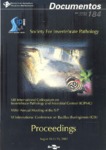Use este identificador para citar ou linkar para este item:
http://www.infoteca.cnptia.embrapa.br/infoteca/handle/doc/449928| Título: | Proceedings... |
| Autoria: | INTERNATIONAL COLLOQUIUM ON INVERTEBRATE PATHOLOGY AND MICROBIAL CONTROL, 8.  INTERNATIONAL CONFERENCE ON BACILLUS THURINGIENSIS 6.   ANNUAL MEETING OF THE SIP, 35., 2002, Foz do Iguassu.   |
| Ano de publicação: | 2002 |
| Referência: | Londrina: Embrapa Soja: Embrapa Recursos Genéticos e Biotecnologia: UEL: SIP, 2002. |
| Páginas: | 312 p. |
| Conteúdo: | Baculovirus genetics and gene regulation; Improvements in insect cell culture for recombinant protein production; Engineered baculovirus insecticides; Interactions between entomopathogenic fungi and predators; Interaction of entomopathogenic fungi, insect parasitoids and their hosts; Interactions between fungi and other entomopathogens; Interactions between entomopathogenic fungi and chemicals pesticides; Contributíons of invertebrate pathology to vector control; Yellow fever in South America; Dengue transmission and Aedes aegypti control in Brazil; West Nile vírus: an exotic emerging pathogen in North America; Ecology of entomopathogenic fungi in field soils; Phyllosphere ecology of terrestrial entomopathogenic fungi; Endophytic fungi as agents for the biological control of insects; Microecology of entomopathogenic fungi from aquatic environments; The successful use of AgMNPV for the control of velvetbean caterpillar, Anticarsia gemmatalis, in soybean in Brazil; Development of Spodoptera frugiperda nucleopolyhedrovirus as a bioinsecticide in Mexico and Central America; Development of wild-type and recombinant HaSNPVs as viral pesticides for the control of cotton bollworm in China; Use of engineered baculoviruses as biopesticides: reality and prospects; Worldwide production and use of entomopathogenic nematodes; Entomopathogenic nematode diversity in South America: opportunities for exploration; Development of entomopathogenic nematodes as a management tactic for citrus root weevils in Florida; Advances in the use of entomopathogenic nematodes for the management of scarab pests; Entomopathogenic nematodes: research and implementation in South America Countries; Entomopathogenic nematodes: research and implementation in Mexico and Central America countries; The future of scientific publications: introduction and the scientific society's viewpoint; The future of scientific publishing - the publisher's viewpoint; Electronic publishing: open access, integration and interoperability; The future of scientific publications: one scientist's perspective; The future of scientific publications: the librarian's viewpoint; The diverse armoury of the Bt crystal; The toxin-coding plasmid of Bacillus thuringiensis subsp. israelensis: host regulation and a new toxin gene; DNA shuffling of Bacillus thuringiensis crystal proteins; The genetic structure of members from the Entomophthora muscae species complex proposes high host specificity and clonal life history strategies; Parasexuality and its significance in natural populations of entomopathogenic fungi; Environmental sensing in Bacilli: a basis for host specificity; Identification of new Bacillus thuringiensis virulence genes by genetic approaches; Xenorhabdus and Photorhabdus virulence factors and their impacts on insect cellular immunity; Insect/Serratia interactions: the question of virulence; Bacteria production and use in some Latin American countries; Mass production of nucleopolyhedrovirus for the control of the velvetbean caterpillar, Anticarsia gemmatallis Hübner, in soybeans; Technical aspects of the industrial production of entomopathogenic fungi in Brazil; Fungi for coffee berry borer control; Thirty years of massproduction and extensive application of entomogenous fungi in China; Global perspectives on the discovery, isolation, preservation, and exploitation of entomopathogenic fungal germplasm; Managing microsporidian germplasm; Entomopatogenic bacteria repositories; Perspectives and challenges facing insect viral germplasm repositories; Ecological genetics of entomopathogenic nematodes: are there metopopulations?; Evaluating nontarget effects on below ground invertebrates; Virulence mechanism of a slug-parasitic nematode and its associated bacterium; Current status of B. thuringiensis resistance and B. thuringiensis resistance-management in Bt cotton in the U.S.; Bacillus thuringiensis toxin and nematodes: mechanisms of resistance and toxicity; Managing resistance to Bt plants through use of gene and promoter strategies and field tactics; Transgenic Bt rice expressing a synthetic cry 1 B gene: expression strategies and field protection against the striped stem borer; Tools of the solar-UV trade: light sources, filtering, measuring irradiance and selecting biological weighting factors (action spectra); Damage to fungi from solar/UV exposure, and genetic and molecular-biology approaches to mitigation; Mitigation of solar damage to microbial control agents through formulation and application technology; Origin and metabolic adaptation in microsporidia; Characteristics of the microsporidia; reasons to ponder that microsporidia are highly evolved fungi; Microsporidian roots and branches within the Zygomycota? take a number and step in line!; Insect pests of potatoes in the Western Hemisphere and the potential for their control using entomopathogens; Microbial control of potato tuber moth and Andean potato weevil in South America; The discovery, development and death of Bacillus thuringiensis var. tenebrionis as a microbial control product for the Colorado potato beetle; Microbial control of Colorado potato beetle in potatoes in rain-fed potato agroecosystems in the Northeastern US.; Microbial control of insect pests of potato in Canada and the Western United States; Integration of insect-resistant transgenic plants, predators and parasitoids, and microbial agents for the control of potato pest insects; Development of international scientific biosafety testing guidelines for transgenic plants; Considerations for research in agricultural biotechnology; Workshop in methods for the preservation of fungal cultures; Microbial control of the coffee berry borer in Colombia; Microbiological control of the coffee berry borer in Brazil; Use of fungal pathogens for the management of coffee berry borer, Hypothenemus hampei - the Indian experience; Bacillus thuringiensis and Bacillus sphaericus useful tools for mosquito and blackfly control a short history of two insecticides development; Bacillus thuringiensis israelensis: a model for improving microbial insecticides for mosquito control; Strains and application strategies for improving the use of Bacillus sphaericus and B. thuringiensis against mosquitoes; Molecular characterization of a resistance mechanism to the Bacillus sphaericus binary toxin in Culex pipiens. |
| Thesagro: | Bactéria Bacillus thuringiensis Controle microbiano Animal |
| NAL Thesaurus: | Invertebrates |
| Palavras-chave: | Patologia animal |
| Série: | (Embrapa Soja. Documentos, 184; Embrapa Recursos Genéticos e Biotecnologia, 74). |
| Tipo do Material: | Anais e Proceedings de eventos |
| Acesso: | openAccess |
| Aparece nas coleções: | Série Documentos (CNPSO)  |
Arquivos associados a este item:
| Arquivo | Descrição | Tamanho | Formato | |
|---|---|---|---|---|
| ID19029final.pdf | 27,17 MB | Adobe PDF |  Visualizar/Abrir |









